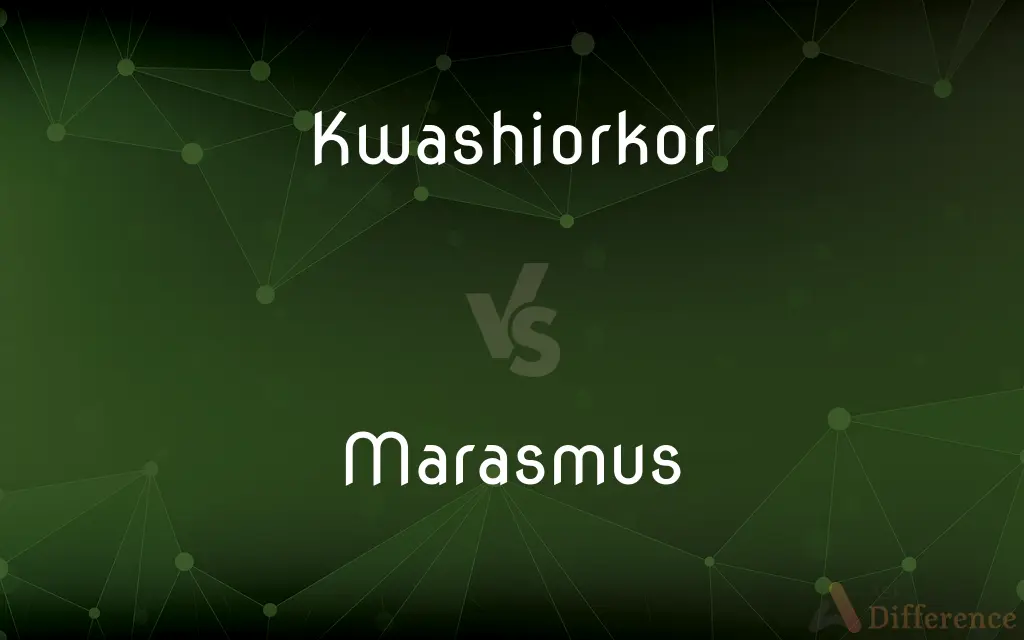Kwashiorkor vs. Marasmus — What's the Difference?
By Tayyaba Rehman — Updated on September 21, 2023
Kwashiorkor is protein malnutrition; Marasmus is overall calorie deficiency.

Difference Between Kwashiorkor and Marasmus
Table of Contents
ADVERTISEMENT
Key Differences
Kwashiorkor primarily results from a protein-poor diet, whereas Marasmus stems from an overall caloric insufficiency.
The hallmark sign of Kwashiorkor is edema (swelling), but Marasmus is characterized by severe muscle wasting and weight loss.
While children with Kwashiorkor may have a bloated belly, Marasmus leads to a skeletal appearance due to extreme muscle and fat loss.
Dietary treatments for Kwashiorkor focus on providing adequate protein, while for Marasmus, a balanced caloric intake is crucial.
Both Kwashiorkor and Marasmus can have serious health implications, but their causes and presentations differ significantly.
ADVERTISEMENT
Comparison Chart
Primary Cause
Protein deficiency
Overall calorie deficiency
Characteristic Look
Bloated belly due to edema
Skeletal appearance with muscle wasting
Age Group
Common in children 1-3 years
Common in children under 1 year
Other Symptoms
Skin changes, irritability, fatty liver
Severe weight loss, growth retardation
Treatment Focus
Increase protein intake
Increase overall calorie intake
Compare with Definitions
Kwashiorkor
A form of malnutrition caused by protein deficiency.
Children in certain regions suffer from Kwashiorkor due to limited protein sources.
Marasmus
A condition characterized by extreme weight loss and muscle wasting.
The doctor diagnosed the child with Marasmus due to evident muscle wasting.
Kwashiorkor
A nutritional disorder with edema and skin changes.
Health professionals identified Kwashiorkor in the child due to the evident skin patches.
Marasmus
A starvation-induced condition often seen in infants.
The infant's skeletal appearance raised concerns of Marasmus among healthcare workers.
Kwashiorkor
A syndrome with a distended abdomen in malnourished children.
The distended belly of the child indicated a possible case of Kwashiorkor.
Marasmus
A form of undernutrition from inadequate intake of proteins and calories.
Without a balanced diet, children in the camp were at risk of developing Marasmus.
Kwashiorkor
Disease often seen in famine conditions with inadequate protein supply.
During the famine, many children displayed symptoms of Kwashiorkor.
Marasmus
A result of prolonged dietary deficiency affecting growth and development.
Without proper nutrition, the child's growth was stunted, pointing towards Marasmus.
Kwashiorkor
Result of imbalanced protein-to-calorie intake.
The village faced cases of Kwashiorkor when their primary food lacked protein content.
Marasmus
A severe malnutrition due to caloric insufficiency.
Regions with food scarcity often witness children suffering from Marasmus.
Kwashiorkor
Kwashiorkor (“kwah-shee-awr-kawr” or “-ker”, IPA: , ) is a form of severe protein malnutrition characterized by edema and an enlarged liver with fatty infiltrates. It is thought to be caused by sufficient calorie intake, but with insufficient protein consumption (or good quality protein), which distinguishes it from marasmus.
Marasmus
Marasmus is a form of severe malnutrition characterized by energy deficiency. It can occur in anyone with severe malnutrition but usually occurs in children.
Kwashiorkor
Severe protein malnutrition, especially in children after weaning, marked by lethargy, growth retardation, anemia, edema, potbelly, skin depigmentation, and hair loss or change in hair color.
Marasmus
A progressive wasting of the body, occurring chiefly in young children and associated with insufficient intake or malabsorption of food.
Kwashiorkor
(pathology) A form of malnutrition, found in children, caused by dietary insufficiency of protein in combination with a high-carbohydrate diet.
Marasmus
(medicine) A condition of chronic undernourishment especially in children, caused by a diet deficient in calories or the inability to digest protein and presenting as a severe loss of body weight.
Marasmus senilis
Kwashiorkor
Severe malnutrition in children resulting from a diet excessively high in carbohydrates and low in protein
Marasmus
A wasting of flesh without fever or apparent disease; a kind of consumption; atrophy; phthisis.
Pining atrophy,Marasmus, and wide-wasting pestilence.
Marasmus
Extreme malnutrition and emaciation (especially in children); can result from inadequate intake of food or from malabsorption or metabolic disorders
Common Curiosities
What causes Kwashiorkor?
Kwashiorkor is caused primarily by protein deficiency.
At what age is Kwashiorkor most common?
It's most common in children aged 1-3 years.
Is Marasmus caused by the same deficiencies as Kwashiorkor?
No, Marasmus is caused by an overall caloric deficiency.
How does a child with Marasmus look?
Marasmus leads to a skeletal appearance with severe muscle wasting.
Which condition is marked by edema or swelling?
Kwashiorkor often presents with edema.
Are skin changes a symptom of Kwashiorkor?
Yes, Kwashiorkor can lead to skin changes and irritability.
Can Kwashiorkor and Marasmus coexist?
Yes, a child can show symptoms of both conditions simultaneously, known as Marasmic Kwashiorkor.
What's the primary treatment focus for Marasmus?
For Marasmus, increasing the overall caloric intake is essential.
Is Marasmus always a result of food scarcity?
Not always. While often due to food scarcity, Marasmus can also result from conditions that hinder nutrient absorption.
Are Kwashiorkor and Marasmus preventable?
Both conditions are preventable with adequate nutrition and early intervention.
How about Marasmus? Which age group does it affect most?
Marasmus is most common in children under 1 year.
Can adults suffer from Kwashiorkor or Marasmus?
While more common in children, adults can also develop both conditions in severe malnutrition scenarios.
Are the effects of Kwashiorkor permanent?
If untreated, Kwashiorkor can lead to long-term complications, but early intervention can reverse many effects.
How is Marasmus diagnosed?
Diagnosis is typically based on physical appearance, growth measurements, and dietary history.
What regions are most affected by Kwashiorkor and Marasmus?
Both conditions are most prevalent in areas with food insecurity, especially parts of Africa and South Asia.
Share Your Discovery

Previous Comparison
Monitor vs. Track
Next Comparison
Myeloblast vs. LymphoblastAuthor Spotlight
Written by
Tayyaba RehmanTayyaba Rehman is a distinguished writer, currently serving as a primary contributor to askdifference.com. As a researcher in semantics and etymology, Tayyaba's passion for the complexity of languages and their distinctions has found a perfect home on the platform. Tayyaba delves into the intricacies of language, distinguishing between commonly confused words and phrases, thereby providing clarity for readers worldwide.














































